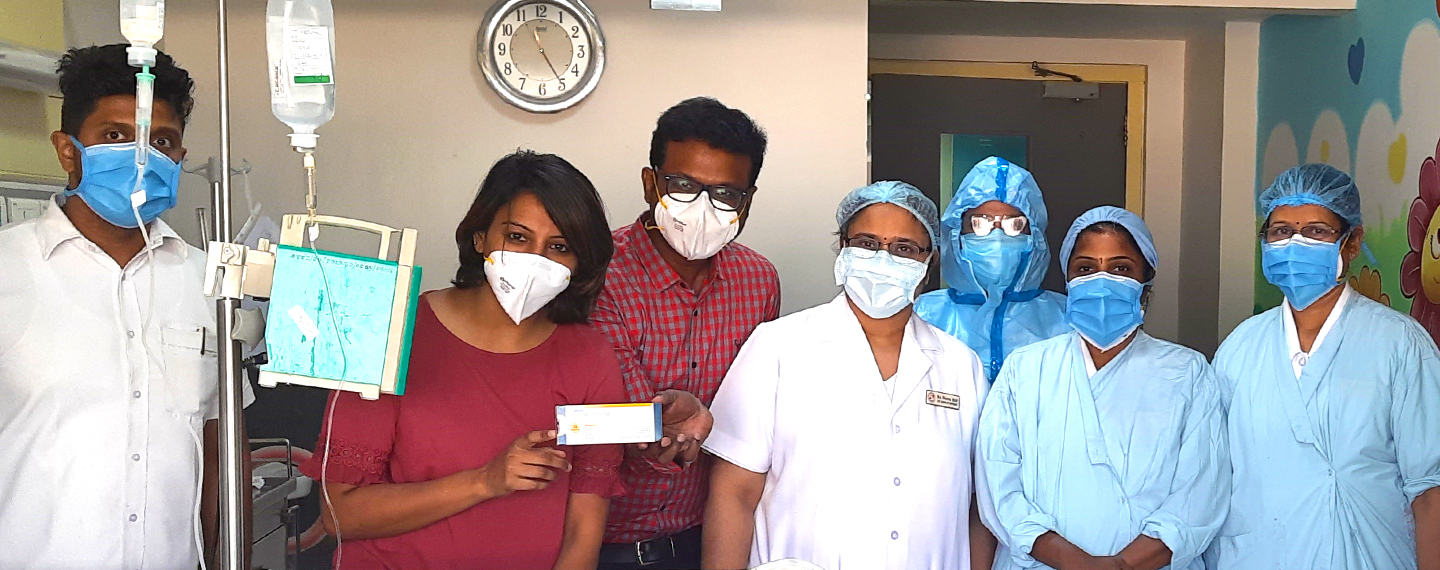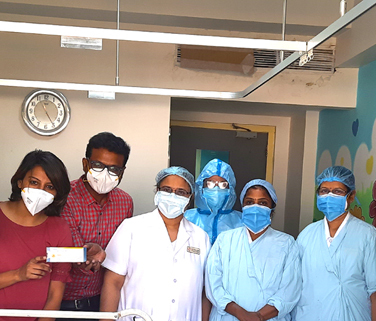Children being treated for pediatric cancers in regions like India and Pakistan often face multiple barriers to receiving biologic medicines, including a lack of access to the medicines themselves, and a lack of awareness about the latest medicines among healthcare professionals. To help address these unmet needs, Amgen recently launched the BLINCYTO® Humanitarian Access Program.
The pilot program, supported by expertise from St. Jude Children’s Research Hospital and run by Direct Relief, a 501(c)(3) humanitarian medical aid organization, will donate BLINCYTO (blinatumomab) to designated hospitals in India and Pakistan. The program began in India in 2020 and was launched in Pakistan in March 2021. Pediatric patients with B-cell precursor Acute Lymphoblastic Leukemia (ALL) who are eligible for BLINCYTO can apply for access to this treatment through their treating physician. Children who relapse with ALL face a poor prognosis and there is an urgent need for additional treatment options, particularly for those who are identified as high-risk.
“We believe that one of the best ways we can serve our patients is to get our medicines to patients in need, and to strengthen local capacity among healthcare workers who serve them,” said Darryl Sleep, chief medical officer at Amgen. “The impact of a cancer like ALL is devastating for children and their families, and we hope that the access to BLINCYTO brings much needed hope to these patients as they continue their treatment.”
“Direct Relief is deeply appreciative to Amgen for its leadership and commitment to making crucial medicines accessible to those who need them, regardless of their ability to pay,” said Thomas Tighe, President and CEO of Direct Relief. “Thanks to this collaboration, children who would otherwise be unable to access cancer therapies will be able to receive the treatments they need.”
Amgen also recognizes the importance of education efforts to strengthen the healthcare systems in these regions. The program will provide critical site-specific training and education to healthcare workers and pharmacists on BLINCYTO, an advanced immuno-oncology treatment in ALL, including appropriate administration, dosing, side-effect management and supportive care.
“More than 90% of children with cancer live in low- and middle-income countries where access to important medications and treatment is limited or non-existent,” said Carlos Rodriguez-Galindo, MD, St. Jude Children’s Research Hospital executive vice president and director of St. Jude Global. “Amgen’s BLINCYTO Humanitarian Access Program will provide this important treatment for children with acute lymphoblastic leukemia, improving their chances of survival. We are pleased to work with Amgen to help reduce the global disparities in access to medicines that will bring us closer to achieving our dream that no child should die from cancer.”
Click here for more information on Amgen’s access initiatives.
IMPORTANT SAFETY INFORMATION
WARNING: CYTOKINE RELEASE SYNDROME and NEUROLOGICAL TOXICITIES
- Cytokine Release Syndrome (CRS), which may be life-threatening or fatal, occurred in patients receiving BLINCYTO®. Interrupt or discontinue BLINCYTO® and treat with corticosteroids as recommended.
- Neurological toxicities, which may be severe, life-threatening or fatal, occurred in patients receiving BLINCYTO®. Interrupt or discontinue BLINCYTO® as recommended.
Contraindications
BLINCYTO® is contraindicated in patients with a known hypersensitivity to blinatumomab or to any component of the product formulation.
Warnings and Precautions
- Cytokine Release Syndrome (CRS): CRS, which may be life-threatening or fatal, occurred in 15% of patients with R/R ALL and in 7% of patients with MRD-positive ALL. The median time to onset of CRS is 2 days after the start of infusion and the median time to resolution of CRS was 5 days among cases that resolved. Closely monitor and advise patients to contact their healthcare professional for signs and symptoms of serious adverse events such as fever, headache, nausea, asthenia, hypotension, increased alanine aminotransferase (ALT), increased aspartate aminotransferase (AST), increased total bilirubin (TBILI), and disseminated intravascular coagulation (DIC). The manifestations of CRS after treatment with BLINCYTO® overlap with those of infusion reactions, capillary leak syndrome, and hemophagocytic histiocytosis/macrophage activation syndrome. If severe CRS occurs, interrupt BLINCYTO® until CRS resolves. Discontinue BLINCYTO® permanently if life-threatening CRS occurs. Administer corticosteroids for severe or life-threatening CRS.
- Neurological Toxicities: Approximately 65% of patients receiving BLINCYTO® in clinical trials experienced neurological toxicities. The median time to the first event was within the first 2 weeks of BLINCYTO® treatment and the majority of events resolved. The most common (≥ 10%) manifestations of neurological toxicity were headache and tremor. Severe, life‐threatening, or fatal neurological toxicities occurred in approximately 13% of patients, including encephalopathy, convulsions, speech disorders, disturbances in consciousness, confusion and disorientation, and coordination and balance disorders. Manifestations of neurological toxicity included cranial nerve disorders. Monitor patients for signs or symptoms and interrupt or discontinue BLINCYTO® as outlined in the PI.
- Infections: Approximately 25% of patients receiving BLINCYTO® in clinical trials experienced serious infections such as sepsis, pneumonia, bacteremia, opportunistic infections, and catheter-site infections, some of which were life-threatening or fatal. Administer prophylactic antibiotics and employ surveillance testing as appropriate during treatment. Monitor patients for signs or symptoms of infection and treat appropriately, including interruption or discontinuation of BLINCYTO® as needed.
- Tumor Lysis Syndrome (TLS), which may be life-threatening or fatal, has been observed. Preventive measures, including pretreatment nontoxic cytoreduction and on-treatment hydration, should be used during BLINCYTO® treatment. Monitor patients for signs and symptoms of TLS and interrupt or discontinue BLINCYTO® as needed to manage these events.
- Neutropenia and Febrile Neutropenia, including life-threatening cases, have been observed. Monitor appropriate laboratory parameters (including, but not limited to, white blood cell count and absolute neutrophil count) during BLINCYTO® infusion and interrupt BLINCYTO® if prolonged neutropenia occurs.
- Effects on Ability to Drive and Use Machines: Due to the possibility of neurological events, including seizures, patients receiving BLINCYTO® are at risk for loss of consciousness, and should be advised against driving and engaging in hazardous occupations or activities such as operating heavy or potentially dangerous machinery while BLINCYTO® is being administered.
- Elevated Liver Enzymes: Transient elevations in liver enzymes have been associated with BLINCYTO® treatment with a median time to onset of 3 days. In patients receiving BLINCYTO®, although the majority of these events were observed in the setting of CRS, some cases of elevated liver enzymes were observed outside the setting of CRS, with a median time to onset of 19 days. Grade 3 or greater elevations in liver enzymes occurred in approximately 7% of patients outside the setting of CRS and resulted in treatment discontinuation in less than 1% of patients. Monitor ALT, AST, gamma-glutamyl transferase, and TBILI prior to the start of and during BLINCYTO® treatment. BLINCYTO® treatment should be interrupted if transaminases rise to > 5 times the upper limit of normal (ULN) or if TBILI rises to > 3 times ULN.
- Pancreatitis: Fatal pancreatitis has been reported in patients receiving BLINCYTO® in combination with dexamethasone in clinical trials and the post-marketing setting. Evaluate patients who develop signs and symptoms of pancreatitis and interrupt or discontinue BLINCYTO® and dexamethasone as needed.
- Leukoencephalopathy: Although the clinical significance is unknown, cranial magnetic resonance imaging (MRI) changes showing leukoencephalopathy have been observed in patients receiving BLINCYTO®, especially in patients previously treated with cranial irradiation and antileukemic chemotherapy.
- Preparation and administration errors have occurred with BLINCYTO® treatment. Follow instructions for preparation (including admixing) and administration in the PI strictly to minimize medication errors (including underdose and overdose).
- Immunization: Vaccination with live virus vaccines is not recommended for at least 2 weeks prior to the start of BLINCYTO® treatment, during treatment, and until immune recovery following last cycle of BLINCYTO®.
- Risk of Serious Adverse Reactions in Pediatric Patients due to Benzyl Alcohol Preservative: Serious and fatal adverse reactions including “gasping syndrome,” which is characterized by central nervous system depression, metabolic acidosis, and gasping respirations, can occur in neonates and infants treated with benzyl alcohol-preserved drugs including BLINCYTO® (with preservative). When prescribing BLINCYTO® (with preservative) for pediatric patients, consider the combined daily metabolic load of benzyl alcohol from all sources including BLINCYTO® (with preservative) and other drugs containing benzyl alcohol. The minimum amount of benzyl alcohol at which serious adverse reactions may occur is not known. Due to the addition of bacteriostatic saline, 7-day bags of BLINCYTO® solution for infusion with preservative contain benzyl alcohol and are not recommended for use in any patients weighing < 22 kg.
Adverse Reactions
- The most common adverse reactions (≥ 20%) in clinical trial experience of patients with MRD-positive B-cell precursor ALL (BLAST Study) treated with BLINCYTO® were pyrexia (91%), infusion-related reactions (77%), headache (39%), infections (pathogen unspecified [39%]), tremor (31%), and chills (28%). Serious adverse reactions were reported in 61% of patients. The most common serious adverse reactions (≥ 2%) included pyrexia, tremor, encephalopathy, aphasia, lymphopenia, neutropenia, overdose, device related infection, seizure, and staphylococcal infection.
- Adverse reactions that were observed more frequently (≥ 10%) in the pediatric population compared to the adults with relapsed or refractory B-cell precursor ALL were pyrexia (80% vs. 61%), hypertension (26% vs. 8%), anemia (41% vs. 24%), infusion-related reaction (49% vs. 34%), thrombocytopenia (34% vs. 21%), leukopenia (24% vs. 11%), and weight increased (17% vs. 6%).
- In pediatric patients less than 2 years old (infants), the incidence of neurologic toxicities was not significantly different than for the other age groups, but its manifestations were different; the only event terms reported were agitation, headache, insomnia, somnolence, and irritability. Infants also had an increased incidence of hypokalemia (50%) compared to other pediatric age cohorts (15-20%) or adults (17%).
Dosage and Administration Guidelines
- BLINCYTO® is administered as a continuous intravenous infusion at a constant flow rate using an infusion pump which should be programmable, lockable, non-elastomeric, and have an alarm.
- It is very important that the instructions for preparation (including admixing) and administration provided in the full Prescribing Information are strictly followed to minimize medication errors (including underdose and overdose).
INDICATION
- BLINCYTO® is indicated for the treatment of B-cell precursor acute lymphoblastic leukemia (ALL) in first or second complete remission with minimal residual disease (MRD) greater than or equal to 0.1% in adults and children.
- This indication is approved under accelerated approval based on MRD response rate and hematological relapse-free survival. Continued approval for this indication may be contingent upon verification and description of clinical benefit in the confirmatory trials.
Please see full Prescribing Information, including Boxed WARNINGS and Medication Guide, for BLINCYTO®.





